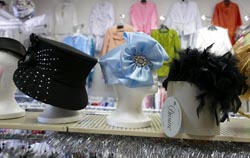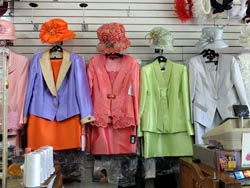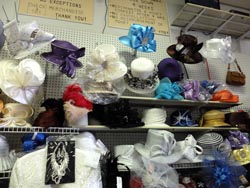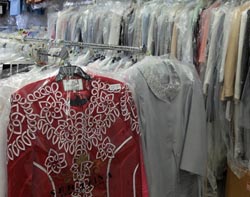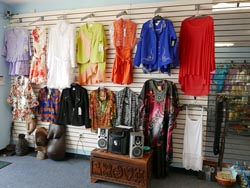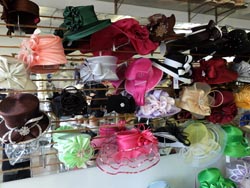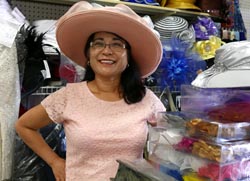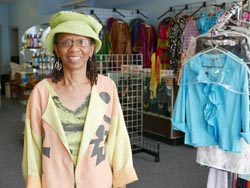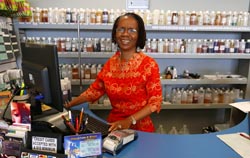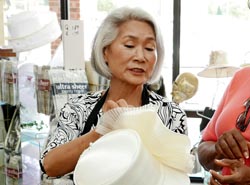Living in Style: The Language of Hats
By Laura Marcus Green
The saying is, and it's true—
a lady is never dressed without a hat.—Aldreamer Smith, Sensational Seniors,
Dr. Leo S. Butler Community Center
In many African American communities, the mere mention of hats brings a smile. Those who wear them—mostly women in their fifties and older—love to talk about their hats. For many, hats are a springboard for nostalgia, evoking mothers, aunties, and grandmothers. Hats are associated with church, but they also are worn at weddings, baptisms, communions, funerals, and teas, among other occasions. A full outfit is a top-to-toe affair, from the hat and dress or suit on down to the purse, jewelry, and shoes. Research with several prominent Baton Rouge milliners revealed much about the place of hats and fashion in people's lives, and about a business that cuts close to customers' heritage and experience.
Customer Service: The Heart of the Trade
In Baton Rouge, people have several choices of boutiques where they can shop for hats. Milliners interviewed for this project include Nomzamo Iyanu of Nomzamo's Boutique, Tony Aguirre, proprietor of Variety Fashion, and Mu Kyong "K" Dickerson of Four Seasons Hat & Wigs. Each of these shops has its own feel and its own specialties. The milliners know their target markets well and play their strengths accordingly. Yet since these savvy businesswomen all serve a similar cultural demographic, there are similarities and themes that emerged in the research.
Some hat wearers make the rounds among the different boutiques, while others find the one that is most to their liking, developing lasting relationships with the proprietors and staff at their favorite shop. As milliners accompany their customers through life's seasons and cycles, there is an intimacy that grows between them, similar to what you might experience in a beauty parlor. When a customer passes away, for example, the family frequently turns to their loved one's milliner to find the right outfit for her to wear for burial. This service is a sacred trust and a comfort to bereaved families. Nomzamo Iyanu relates that her customers' daughters sometimes begin shopping at her store after their mothers pass away, to maintain a connection.
Women who wore hats in life are often buried wearing a hat. By special arrangement with undertakers, hats must be trimmed in the back and customized in order to fit into a coffin. Tony Aguirre of Variety Fashion reports that some families show their love for a person by wearing the same colors as the deceased to the funeral. When this trend first began, it took Tony by surprise, as she was accustomed to black as the traditional color to wear to a funeral. Some of her customers show respect or support for the deceased by wearing a color that relates to a particular illness, such as pink for those who have died from breast cancer.
Hat and wig sellers tend to be knowledgeable about cancer and cancer treatment, and familiar with their customers' health issues. Women who lose their hair during chemotherapy often turn to hat and wig shops to bolster their appearance and self-confidence. K Dickerson of Four Seasons Hat & Wigs knows how to trim a wig and how to care for hair as it is growing back after chemotherapy. Tony Aguirre of Variety Fashion relates that sometimes her customers talk about their medical situations, while others prefer not to speak about them directly. She has learned to be attentive to this distinction and respond accordingly. In fact, all of the milliners interviewed for this project would agree that listening is at the heart of customer service. And customer service is at the heart of the millinery trade.
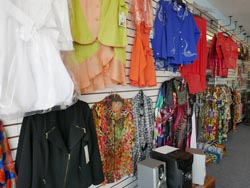
In addition to the women who wear them, some men also shop for hats as gifts for their mothers or grandmothers. Especially in the case where women are regular and longstanding customers at a particular shop, milliners are able to help family members select the right hat. Because sons have grown up learning about their mother's taste in hats, they may not need help picking out a hat for her. Some men give money to the women in their lives, so they can pick out their own hats. Another situation in which milliners help select hats is when customers may not be able to get to the shop themselves due to illness, age, or lack of transportation. These are instances where store owners relax their "no returns" policy, although it is seldom needed since they know their customers so well.
The Economy of Wearing Hats
Women naturally shop where the price points match their budgets. Yet, whether they shop at J.C. Penney's or a boutique, women who wear hats must continually have something new wear to church and to social occasions. It simply will not do to wear the same hat to church within several weeks, months, or even longer, although a new outfit can be achieved by pairing the same hat with a different dress and other accessories, or vice verse.
Not only is it considered bad form to wear the same hat or outfit too soon, but women understandably strive to be distinctive in their dress. Understanding each customer's style and her desire to be unique is another vital tool of the milliners' trade. The milliners interviewed for this project take notice of what their customers buy. Nomzamo Iyanu points out that this type of personalized service distinguishes boutiques from the larger chain stores.
She shares:
That's challenging because if somebody else from [the same] church comes, I need to remember that. And I need to remember what they purchased, and make sure that the first lady don't have the same thing that they have.1 Now you know, that's a lot of work. Dillard's don't have to do that, nor Macy's! They just sell it, you know? And those little things make us special. But it works you to death. And you don't even have the conversation, you know? I'll just say, "Somebody else at your church have that one—you don't want that." "Oh, baby, I'm so glad you told me 'cause I sure didn't want to break out in there." . . . So you try as much as you can.
Since other boutiques may sell the same attire, however it's inevitable that people sometimes show up for church or other occasions in the same outfit.
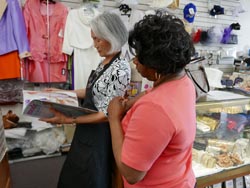
Hats, dresses, and suits are a significant investment, which speaks to their importance in people's lives. The milliners consulted for this project all offer layaway plans. Many of their customers save money to buy special outfits and come in ready to make a purchase. In addition to dresses, suits, and hats, milliners carry modestly priced "bread-and-butter" items, such as nail polish, hose, jewelry, and other accessories. By offering all of the necessities, milliners not only provide a one-stop shopping experience, but they cover an economic spectrum.
Serious hat wearers take good care of their hats, storing them in hatboxes and plastic bags to keep them clean. People often arrange them in their closets by color, so it will be easier to find the right hat for the season or a particular occasion. At one of the hat shops, a customer talked about her arrangement with her husband, wherein she must get rid of a hat whenever she buys a new one. She donates the outgoing hat to her church. Some churches have a "closet" where people bring donated hats and clothing. Those who don't have the means to buy new clothes can "shop" in the church closet.
Hat Trends and Traditions
Since the days of Jacqueline Kennedy's pillbox hats in the 1960s and before, the media has played a role in driving styles and trends. Although hat-wearing has been a waning tradition as women prioritize their hairstyles and understandably don't want to cover their coiffure, milliners report a recent renewal in interest in hats following the 2011 English Royal Wedding between Prince William and Catherine Middleton. Many in the community watched the entire wedding, reveling in the pageantry and the array of hats that were part of it. Following the wedding, customers began seeking fascinators in Baton Rouge hat shops.2 In addition to making a fashion statement, wearing fascinators is a way to spend less money on hats, and for younger women to ease into wearing hats without sporting the larger, showier crowns of their mothers' and grandmothers' generations. Another trendsetting phenomenon was the outfit soul singer Aretha Franklin wore to perform at President Barack Obama's 2009 inauguration. Her hat likewise sparked a fashion sensation.
Digital technology has impacted the way orders and sales are conducted. Nomzamo Iyanu reports selling a hat to a customer by sending her a digital photo from her iPhone. This worked out well, but when the customer wanted to purchase a matching outfit in this manner, however, Nomzamo drew the line, saying, "I think you need to come in and try it on."
While some women wear hats to church each week, others wear them only on special occasions, such as Women's Day, a tradition in many Black churches, or at Easter time and Mother's Day. Some churches host Hat Days, sometimes called Hattitude, as fundraisers or as part of a special program. Hat Day is generally a competitive event, where participants vie for the most innovative hat, among other criteria.
In addition to the edict against wearing the same hat too often, there are other unspoken (albeit commented upon) "hat rules." A person should not wear a hat with a brim wider than her shoulders. A person should not wear a large hat and sit at the front of the church. Of course, as with any rules, these are sometimes broken! Nomzamo Iyanu talked about hats as a form of communication, a "conversation" that reveals much about the wearer. As a milliner, she must tune into the tenor of this conversation so that she can steer customers towards the hat that will best suit the statement she wishes to make through her hat. She comments on this process:
"I have to look at the styles to see—it has to talk to me. Because I know how my customers want to 'talk.' . . . You know, there's a certain conversation, you know." According to Nomzamo, the conversation goes something like this. "'Well, this is a serious hat, you know? I'm a serious person, and this is a fun hat. And I'm bling-blinging now. You can watch me, 'cause I got character, you know?' So those kinds of conversations, talking, letting you know that they're elegant women, you know, and fancy. . . So you have those kinds of conversations going on. The hats really talk."
The hats may talk but, again, the milliners listen. Both Nomzamo Iyanu and K Dickerson teach their staff not to offer opinions when customers try on hats and other attire and ask for feedback. The milliners know their customers and might select certain hats for them try on, but ultimately they'll defer to the customer, asking, "What do you think?" While the milliners stock their shops with apparel they know will appeal to their customers and provide guidance in showing them particular items, turning this question around puts the accountability back on the customer. It's a delicate dance, but one the milliners know well.
None of the milliners interviewed for this project expected to find themselves in the apparel trade. Each found her way to this work serendipitously but once there, discovered a natural calling. These three women have put their own unique stamp on their shops, and customers seek them out accordingly.
Tony Aguirre, Variety Fashion
Tony Aguirre never imagined herself going into the millinery business. She grew up in a rural farming town in South Korea, where clothing was not a particular focus in her life. Her husband, Arturo Aguirre, a native of south Texas, was in the military in South Korea when they met. After moving to the United States in 1979, they lived in various locations before settling in Baton Rouge, where they have made their home ever since.
Once their three sons were in school, Tony began to think about working outside of the home. As she made this transition, she thought she would be best suited for a position in business. When finding a job proved difficult, she went to work for a friend, selling knick-knacks at a flea market. She found that she liked sales, and opened her own storefront business, Variety Fashion, in 1997. The store is still in its original location, a small strip mall-style shopping center on Government Street. Tony began her business by selling all manner of merchandise, from beauty products to children's clothing, hence the name, Variety Fashion. As she came to know her clientele, she found her niche in women's "church wear," for which she has long been known.
Sometimes it's a full house over here! That little store is a full house, and I just--it's fun! You know? Because sometimes they just came in, and another person comes in. Sometimes they know each other. So it's just like a family fun day! That's why I like this job! Long as the customers are here, I'm happy. But if I have no customers, I have my personal time.
Tony's husband, Arturo Aguirre, takes an active part in the business. He often comes to the shop at the end of his work day and on weekends to keep Tony company and help out where needed. He has been supportive of the business from day one. When the Aguirres first started out, they learned the trade by visiting regional garment districts, especially in Houston, Texas. After so many years in the business, Tony knows her customers' tastes well, and is now consulted by the manufacturers about what will sell in her shop. These days, the traveling salesmen come to her; she no longer travels to markets to buy her merchandise.
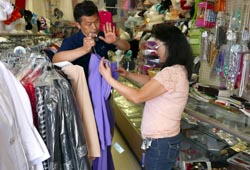
Since she specializes in church wear, Tony's customers tend to be older women, of whom she is especially fond. Through her business, she has come to know the local culture and her customers on a personal basis. She takes the time to visit with them, and talk to them about their problems and life situations, in addition to outfitting them for church and other occasions. Tony takes special care of her elder customers, walking them to their car to ensure their safety, and checking up on them when they don't pick up a special order on time. She believes that this personal attention, the shop's welcoming ambience, and her selection of "blingy" but reasonably priced attire are what keep her customers coming back over the years, some from out-of-state locations. Tony is concerned about what will happen when the older generation is gone, as they are the keepers of the tradition of wearing formal suits and hats to church and other special occasions. Tony loves to see her customers enjoying their clothes. Making them happy is her motivation in the work she does.
Nomzamo Iyanu, Nomzamo's Boutique
Nomzamo Iyanu's apparel and hat business began as a weekend flea market booth that blossomed into a brick-and-mortar store when the insurance company for which she worked relocated out of town and she stayed on in Baton Rouge. In business for over thirty years, Nomzamo has built a loyal clientele based on high standards of customer service and a unique inventory.
By design, Nomzamo caters to a high-end clientele. She takes customer service seriously. All new employees go through a nine-day training to ensure that they maintain her standards. The long-term relationships the shop maintains with customers through care and attentiveness distinguish the more intimate experience in her boutique from the less personal dynamic at large chain department stores. A mix of classic church wear, African attire, and unique boutique clothing, Nomzamo's inventory also sets her apart from other shops in the area. Since she carries African attire in the shop, Nomzamo has learned to tie a head wrap. She teaches her staff and customers to wrap the head scarves that come with African outfits. Nomzamo considers an African outfit incomplete without the head scarf. She has returned outfits if they arrive from the manufacturer without one, as she knows she will be unable to sell them otherwise.
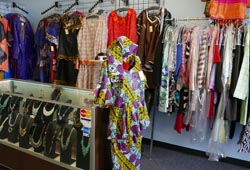
During African American History Month, many local churches hold one or more services where congregants wear African clothing. For this and other African American heritage events, such as Juneteenth, Nomzamo's offers trunk shows featuring African clothing. She has also sponsored African and African American cultural programs, including an annual Kwanzaa celebration. One of her life's missions is to expose people to Kwanzaa and to their African roots.
In fact, we had a customer in last week, she bought an African outfit, she said, "I don't know how to tie those, so I never tie 'em." She said, "I just have them, but I never tie them, and I don't wear them." So I said, "Well today, you're going to learn." And I taught her how and she was like, "Oh my God! I can't believe." She said, "Now I'm going to pull all of them out and I'm going to be wrapping my head." And you can really make it look like a hat, you know? It's amazing. I was taught by the African ladies, and so I'm passing the tradition down, continuing.
Reflecting on her childhood memories of hats, Nomzamo thinks of her grandmother, who never went to church without a hat. Nomzamo's grandmother instilled in her a taste for distinctive styles and for standing out from others—an aesthetic Nomzamo maintains to this day, both in her own attire and shop inventory. She remembers a store in Opelousas, Louisiana, Abdalla's, where her grandmother shopped for special attire. In contrast to other shops in the area at that time, this business served Black customers. However, it did not allow them to try on the clothing.
In addition to clothing and accessories, Nomzamo's carries body products such as oils and soaps, and offers an array of scented oils that customers can adapt to their preference, sometimes based on aromatherapy. Considered an expert on nutrition and wellbeing, Nomzamo is often consulted by her customers about grassroots health care and remedies. Nomzamo's operates as a social hub, where customers come for clothing, counsel, and all manner of information. Reflecting on her more than thirty years in the millinery business, Nomzamo believes that sharing her knowledge is among the most important services she offers, tempered with a generous measure of honesty and humility.
Mu Kyong Dickerson, Four Seasons Hat & Wigs
Mu Kyong "K" Dickerson has lived in Baton Rouge since 1991. She found her way to the millinery business when her children began attending school and she was seeking work outside the home. For her first job, she washed dishes at a friend's restaurant during the lunch shift. After K had worked in the restaurant for a short time, a cousin encouraged her to find work that made better use of her talents. When the hat and wig shop next to the restaurant where she worked went up for sale, her friend who owned the restaurant urged Kyong to consider buying the business, saying, "You could do this." With financial backing from her cousin and support from her husband and friends, K opened the Four Seasons Hat & Wigs shop in 1994.
Previously, while living in Mississippi, she had befriended a Chinese woman who owned a Hallmark franchise and taught Kyong about working in retail. With no other experience in the millinery business, she taught herself what to buy by attending shows in Houston, by watching the news, and looking through magazines. Over twenty years later, she attributes her success to the good teachers she has had along the way—her two friends in retail who trained her.
K also believes she has an innate "sense in her eyes" for fashion. She has a gift for distinguishing among different colors and shades, which helps her put together outfits and provide guidance for her customers. Often, customers arrive at her shop with a dress for which they need a hat to complete the outfit. K hangs the dress above the sales counter and with a long-handled hook, she tries different hats until the customer finds the one that works. Since most hats and dresses or suits come from the manufacturer as separates, K never quite knows how they will work together until she opens the box. She is amazed and happy when the pieces work together.
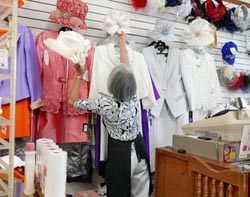
K relishes the freedom of having her own business. Over the twenty-plus years she has owned and operated Four Seasons, she has learned a lot about the culture of wearing hats and other apparel, about the occasions when people wear them, and how to provide the best customer service. Most of K's customers are African American. Among her European-American customers are members of the Red Hat Society, who shop for red and purple hats. There are hats for every occasion. The Kentucky Derby has become a big hat-buying event in recent years. People either travel to Kentucky, carrying their hat boxes with them, or they attend parties closer to home. Many of her customers come to buy hats for church. For special occasions, pastors' wives often seek out something fancy. In contrast, deaconesses wear white hats in a simpler pillbox style. Smaller hats and fascinators-which have been popular since the 2011 Royal Wedding—are worn to teas and bridal showers. People also tend to wear smaller hats to a funeral. Whatever the occasion, people match their outfits top to toe. Although she has absorbed a wealth of knowledge about her work and customers over the years, K says, "Every day, I learn."
Notes
1. The first lady is the pastor's wife.
2. "A fascinator hat is a small ornamental headpiece that fits on the head using an alice-band-type base or headband or even a small comb. It is always lightweight and usually features feathers, beads or flowers. The use of the term fascinator began in the 1990s when such headpieces became popular for wearing at weddings without ruining your lovely hairstyle or giving you a helmet head." Source: http://visforvintage.net/2012/08/30/fascinator-history-of-a-hair-accessory/
Sources
Aguirre, Tony (Variety Fashion). 2015. Interviews by Laura Marcus Green. June 3.
Dickerson, My Kyong (Four Seasons Hat & Wig). 2015. Interview by Laura Marcus Green. March 31.
Iyanu, Nomzamo (Nomzamo's Boutique). 2015. Interviews by Laura Marcus Green. April 2 and June 3.



